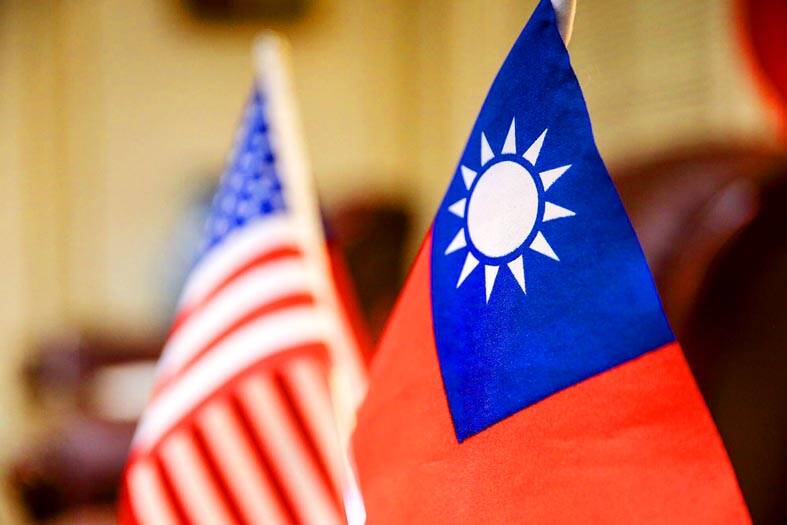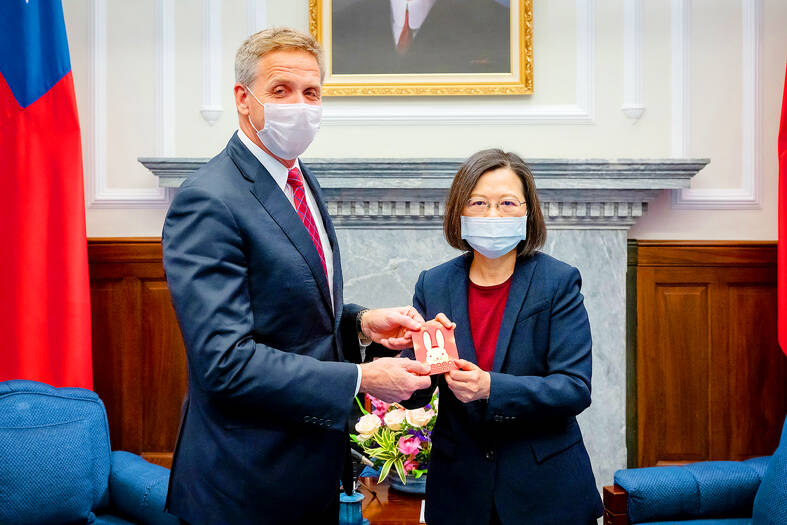If influence in the Indo-Pacific region is one of the US’ core interests, then Taiwan serves as a cornerstone of US economic and security influence in the region, former US Indo-Pacific Command commander admiral Phillip Davidson said on Thursday.
“China’s ... strategy is to supplant the US leadership role in the international order ... and they’ve long said ... that they intend to do that by 2050,” Davidson told the National Review Institute’s Ideas Summit in Washington.
Davidson said he had previously told US Senate hearings on China’s military activities and possible threats in the Indo-Pacific region that a Chinese invasion of Taiwan could happen within the next 10 years, or even the next six years.

Photo: Cheng I-hwa, Bloomberg
That timeline should not be taken as a definitive plan for China to attack, but rather a timeframe in which China would use economic, diplomatic and military means to weaken the US, and create the impression that China is on the rise while the US is in decline, Davidson said.
China has clearly stated its intent to prioritize “internal” security issues, which includes Taiwan, Davidson said, adding that in light of such statements, the US needs stronger deterrents against China.
Taiwan is a core interest for China, and the US’ regional allies are accustomed to gauging US policy reliability based on the Taiwan Relations Act and long-standing US-Taiwan relations, Davidson said.

Photo: EPA-EFE / Makoto Lin / Presidential Office
While the US should reinforce its relations with partners and allies, which includes assisting Taiwan, Taiwan must invest in strengthening its defenses as well, Davidson said.
Elbridge Colby, nominee for US undersecretary of defense for policy, on March 5 said that Taiwan’s defense spending was insufficient and should come closer to 10 percent of GDP.
Davidson also said that in addition to developing asymmetrical combat capabilities, Taiwan’s traditional combat capabilities also need work, citing how Taiwan needs more traditional weapons platforms, including planes, ships and submarines, to counteract Chinese People’s Liberation Army (PLA) harassment.
The PLA frequently sends its jets and planes into the Taiwanese air defense identification zone, flies past the median line of the Taiwan Strait and sails ships around Taiwan, he said.
Asked what were the possible results of Taiwan becoming a part of China, Davidson speculated that Japan and South Korea would contemplate developing their own nuclear umbrella to safeguard their regional interests, challenging the US stance on nuclear proliferation and possibly destabilizing the US-led Asia-Pacific security architecture.

TRAGEDY STRIKES TAIPEI: The suspect died after falling off a building after he threw smoke grenades into Taipei Main Station and went on a killing spree in Zhongshan A 27-year-old suspect allegedly threw smoke grenades in Taipei Main Station and then proceeded to Zhongshan MRT Station in a random killing spree that resulted in the death of the suspect and two other civilians, and seven injured, including one in critical condition, as of press time last night. The suspect, identified as a man surnamed Chang Wen (張文), allegedly began the attack at Taipei Main Station, the Taipei Fire Department said, adding that it received a report at 5:24pm that smoke grenades had been thrown in the station. One man in his 50s was rushed to hospital after a cardiac arrest

PUBLIC SAFETY: The premier said that security would be tightened in transport hubs, while President Lai commended the public for their bravery The government is to deploy more police, including rapid response units, in crowded public areas to ensure a swift response to any threats, President William Lai (賴清德) said yesterday after a knife attack killed three people and injured 11 in Taipei the previous day. Lai made the remarks following a briefing by the National Police Agency on the progress of the investigation, saying that the attack underscored the importance of cooperation in public security between the central and local governments. The attack unfolded in the early evening on Friday around Taipei Main Station’s M7 exit and later near the Taipei MRT’s Zhongshan

ON ALERT: Taiwan’s partners would issue warnings if China attempted to use Interpol to target Taiwanese, and the global body has mechanisms to prevent it, an official said China has stationed two to four people specializing in Taiwan affairs at its embassies in several democratic countries to monitor and harass Taiwanese, actions that the host nations would not tolerate, National Security Bureau (NSB) Director-General Tsai Ming-yen (蔡明彥) said yesterday. Tsai made the comments at a meeting of the legislature’s Foreign Affairs and National Defense Committee, which asked him and Minister of National Defense Wellington Koo (顧立雄) to report on potential conflicts in the Taiwan Strait and military preparedness. Democratic Progressive Party (DPP) Legislator Michelle Lin (林楚茵) expressed concern that Beijing has posted personnel from China’s Taiwan Affairs Office to its

SAFETY FIRST: Double the number of police were deployed at the Taipei Marathon, while other cities released plans to bolster public event safety Authorities across Taiwan have stepped up security measures ahead of Christmas and New Year events, following a knife and smoke bomb attack in Taipei on Friday that left four people dead and 11 injured. In a bid to prevent potential copycat incidents, police deployments have been expanded for large gatherings, transport hubs, and other crowded public spaces, according to official statements from police and city authorities. Taipei Mayor Chiang Wan-an (蔣萬安) said the city has “comprehensively raised security readiness” in crowded areas, increased police deployments with armed officers, and intensified patrols during weekends and nighttime hours. For large-scale events, security checkpoints and explosives